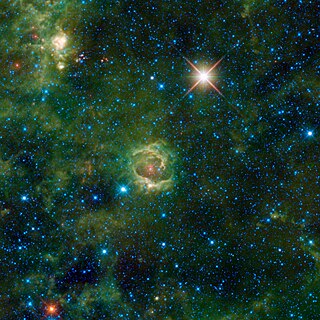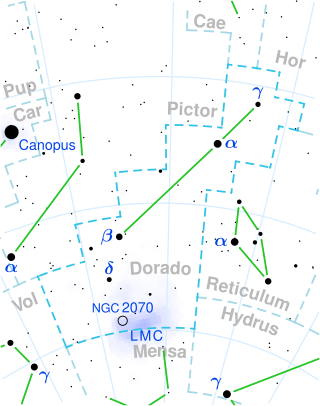Notes
- 1 2 Applying the Stefan–Boltzmann law with a nominal solar effective temperature of 5,772 K:
- .
| Observation data Epoch J2000 Equinox J2000 | |
|---|---|
| Constellation | Canis Major |
| Right ascension | 07h 16m 36.83456s [1] |
| Declination | −23° 18′ 56.1383″ [1] |
| Apparent magnitude (V) | 4.79 [2] |
| Characteristics | |
| Spectral type | K3Ib- [3] or K4III [4] |
| B−V color index | 1.710 [2] |
| Astrometry | |
| Radial velocity (Rv) | +28.05±0.42 [5] km/s |
| Proper motion (μ) | RA: −3.816 [1] mas/yr Dec.: +3.896 [1] mas/yr |
| Parallax (π) | 1.2155 ± 0.0998 mas [1] |
| Distance | 2,700 ± 200 ly (820 ± 70 pc) |
| Details | |
| If a giant star | |
| Mass | 1.90 [2] M☉ |
| Radius | 156 ± 11 [2] [a] R☉ |
| Luminosity | 5,250 [2] L☉ |
| Surface gravity (log g) | 0.70 [2] cgs |
| Temperature | 3,937±141 [2] K |
| Metallicity [Fe/H] | 0.03 [2] dex |
| Age | 1.05 [2] Gyr |
| If a supergiant | |
| Mass | 7.8±0.5 [6] M☉ |
| Radius | 315 [7] R☉ |
| Luminosity | 23,660 [7] L☉ |
| Temperature | 3,986 [7] K |
| Rotational velocity (v sin i) | 7.4±1.0 [8] km/s |
| Age | 35.4±2.0 [6] Myr |
| Other designations | |
| Database references | |
| SIMBAD | data |
145 G. Canis Majoris (HD 56577) is a single [10] K giant or supergiant star in the southern constellation of Canis Major. This star is Gould's 145th of Canis Major in his Uranometria Argentina . [11] Kostjuk erroneously lists it as simply "145 CMa". SIMBAD follows this error in its object query result as "* 145 CMa – Star". [12]
The properties and evolutionary state of 145 G. CMa are disputed, it being classed either as a young massive supergiant or a somewhat older and less massive giant. It has been given two MK spectral classifications: K3Ib [3] (corresponding to a supergiant) and K4III [4] (corresponding to a giant). Tezzlaff et al. gives a large mass of 7.8 M☉ and a young age of 35 million years, [6] while Earle Luck gives a smaller mass of 1.9 M☉ and a higher age of 1.05 billion years. [2] The effective temperature of the star is of 3,980 K, [7] which gives it an orange hue typical of K-type stars. [13]
Based on the assumption that it is a supergiant, 145 CMa has been given a large radius of 315 R☉ and a luminosity of 23,660 L☉. [7] Assuming it is a giant, Earle Luck gives a much lower luminosity of 5,250 L☉ with a corresponding radius of 156 R☉. [a] [2] By the distance implied by its Gaia DR2 parallax, it would have a luminosity of 14,000 L☉, rather high for a giant. [5] An older measurement based on the Hipparcos distance of 435 parsecs (1,420 ly) give a lower luminosity of 5,960 L☉. [14]
The star is one component of a close double, the other being HD 56578 which on its own would be a faint naked-eye star. The two are separated by 27″ . [15] The two stars appear to be unrelated and the close alignment accidental, with HD 56578 being a much closer and less luminous Am star. [16]

Mu Cephei, also known as Herschel's Garnet Star, Erakis, or HD 206936, is a red supergiant or hypergiant star in the constellation Cepheus. It appears garnet red and is located at the edge of the IC 1396 nebula. It is a 4th magnitude star easily visible to the naked eye under good observing conditions. Since 1943, the spectrum of this star has served as a spectral standard by which other stars are classified.

Omicron1 Canis Majoris is a red supergiant star in the constellation Canis Major. It is also a variable star.

Sigma Canis Majoris, also named Unurgunite, is a variable star in the southern constellation of Canis Major. It is approximately 1,290 light-years from the Sun and has an average apparent visual magnitude of +3.41.

UW Canis Majoris is a star in the constellation Canis Major. It is classified as a Beta Lyrae eclipsing contact binary and given the variable star designation UW Canis Majoris. Its brightness varies from magnitude +4.84 to +5.33 with a period of 4.39 days. Bode had initially labelled it as Tau2 Canis Majoris, but this designation had been dropped by Gould and subsequent authors. It is visible to the naked eye of a person under good observing conditions.

R Centauri is a Mira variable star in the constellation Centaurus.
KW Sagittarii is a red supergiant star, located approximately 2,420 parsecs away from the Sun in the direction of the constellation Sagittarius. It is one of the largest known stars, with a diameter about 1,000 times larger than the Sun. If placed at the center of the Solar System, the star's surface would engulf Mars, coming close to Jupiter's orbit.
V354 Cephei is a red supergiant star located within the Milky Way. It is an irregular variable located over 13,000 light-years away from the Sun. It has an estimated radius of 1,139 solar radii. If it were placed in the center of the Solar System, it would extend to between the orbits of Mars and Jupiter.

EZ Canis Majoris is binary system in the constellation of Canis Major. The primary is a Wolf-Rayet star and it is one of the ten brightest Wolf-Rayet stars, brighter than apparent magnitude 7.

V381 Cephei is a triple star system in the northern constellation of Cepheus. Its apparent magnitude is slightly variable between 5.5 and 5.7.

V602 Carinae is a red supergiant and variable star of spectral type M3 in the constellation Carina. It is considered to be one of largest known stars, being around 1,000 times larger than the Sun.

PZ Cassiopeiae is a red supergiant star located in the constellation of Cassiopeia, and a semi-regular variable star.

UY Scuti (BD-12°5055) is a red supergiant star, located 5,900 light-years away in the constellation Scutum. It is also a pulsating variable star, with a maximum brightness of magnitude 8.29 and a minimum of magnitude 10.56, which is too dim for naked-eye visibility. It is considered to be one of the largest known stars, with a radius estimated at 909 solar radii, thus a volume of 750 million times that of the Sun. This estimate implies if it were placed at the center of the Solar System, its photosphere would extend past the orbit of Mars or even the asteroid belt.

V915 Scorpii is a hypergiant and semiregular variable star, located 1,718 parsecs (5,600 ly) away in the constellation Scorpius. Its apparent magnitude varies between 6.22 and 6.64, being heavily diminshed by 2.93 magnitudes due to interstellar extinction. When it is at its brightest, it is very faintly visible to the naked eye under excellent observing conditions.

TV Geminorum is a variable red supergiant in the constellation Gemini. Its visual magnitude varies from 6.3 to 7.5, making it very faintly visible to the naked eye of an observer with excellent observing conditions, when the star is near its peak brightness.

V528 Carinae is a variable star in the constellation Carina.

BO Carinae, also known as HD 93420, is an irregular variable star in the constellation Carina.

Westerlund 1 W237, also known as Wd 1-237 or Westerlund 1 BKS B, is a possible red supergiant (RSG) in the constellation of Ara. It is one out of four known red supergiants in the Westerlund 1 super star cluster. As a red supergiant, it would be one of the largest known stars and one of the most luminous of its type.

HD 199223 is a double star in the equatorial constellation Delphinus. However, the system was originally in Equuleus prior to the creation of official IAU constellation borders. The components have a separation of 2″ at a position angle of 282° as of 2016. They have apparent magnitudes of 6.34 and 7.49 and distances of 354 and 359 light years respectively. The system is drifting closer with a radial velocity of −33 km/s.

HD 22764, also known as HR 1112, is an orange hued star located in the northern circumpolar constellation Camelopardalis. It has an apparent magnitude of 5.78, allowing it to be faintly visible to the naked eye. The object is located relatively far at a distance of approximately 1,770 light years based on Gaia DR3 parallax measurements but is approaching the Solar System with a heliocentric radial velocity of −12.5 km/s. At its current distance, HD 22764's brightness is diminished by 0.66 magnitudes due to interstellar dust.

HD 271182, occasionally referred to as G266 and R92, is a rare yellow hypergiant (YHG) and an Alpha Cygni variable. It is one of the brightest stars in the Large Magellanic Cloud (LMC), positioned in the deep southern constellation of Dorado. Gaia DR2 parallax measurements indicate that it is located around 200,000 light-years away, though this value is extremely uncertain. Despite this vast distance from Earth, the star is observable through a small telescope due to its immense luminosity, at an apparent magnitude of 9.6. It is receding away from the Sun at a heliocentric radial velocity of +311.9185 km/s, confirming its membership in the LMC.